The Ultrafast X-ray Imager

The Ultrafast X-ray Imager is the world’s fastest multi-frame solid-state camera (50 times faster) that can capture a sequence of images with user-selectable exposure times as short as 2 billionths of a second. Our camera was developed to enable scientists to study the heating and compression of fusion targets in the quest to harness the energy process that powers the stars. These cameras are being used at Sandia’s Z machine and at the National Ignition Facility at Lawrence Livermore National Laboratory. (1700, 1600)
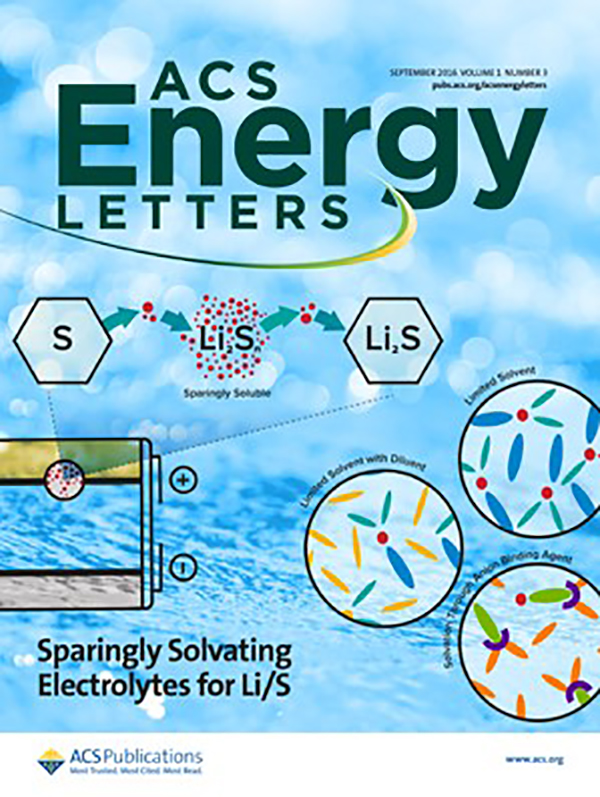
The High-Efficiency Adaptable Telemetry Transmitter (HEATT)
The development of sparingly solvating electrolytes for lithium-sulfur (Li-S) batteries surmounts a critical barrier to creating high energy density (400 Wh/kg(L)), low cost ($100/kWh) transportation power sources. Transportation Storage team lead Kevin Zavadil, together with a team from DOE’s Joint Center for Energy Storage Research (JCESR), have demonstrated how electrolytes in Li-S batteries can be engineered to reduce capacity loss and extend cycle life, providing a path to achieve DOE transportation storage goals for a new generation of battery technology beyond Li-ion. (1800)
Ford Motor Company, Arbin Instruments, Sandia, and Montana Tech recently completed the ARPA-E AMPED project to design, build, and validate a new high-precision, high-current battery tester for automotive and stationary applications. The tester significantly improves battery life predictions, helping meet the growing demand for better, longer-life electrified vehicle and grid storage batteries. Arbin intends to continue commercializing its high-precision technology, while Sandia and Ford will continue validation work, incorporating next-generation cells into future efforts. In November, the team received the 2016 R&D 100 Green Tech Special Recognition Award. (2500)
Sandia surpassed its 30 percent by 2015 energy intensity reduction goal with a 30.87 percent reduction at the end of September 2015 (relative to FY2003 energy intensity baseline) as reported in the FY2016 Site Sustainability Plan. This year, a new goal was set to 25 percent by 2025 with 2.5 percent reductions annually. Data shows that Sandia reached a 2.5 percent reduction for fiscal year 2016. (4800)
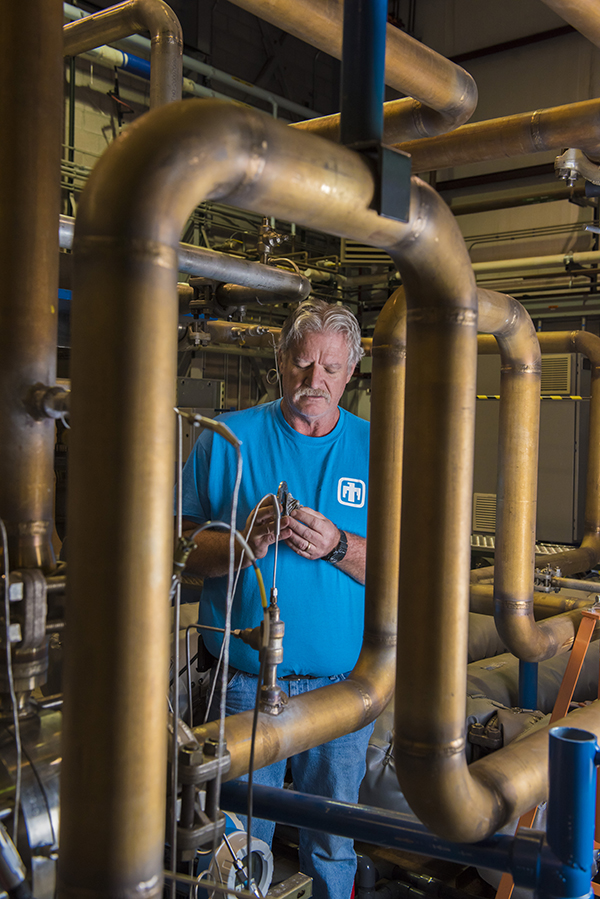
In Sandia’s supercritical CO2 Brayton laboratory development platform. (Photo by Randy Montoya)
DOE’s Supercritical Transformational Electric Power (STEP) program seeks to facilitate commercialization of supercritical carbon dioxide (sCO2) technology. The Technology Roadmap details the current status of technology policy and market considerations, analyzes gaps and needs, and outlines the steps necessary for successful development and deployment of the STEP demonstration system by the end of FY19. This demo is the baseline focus that sets the foundations for the long-term goal of commercialization by 2025. (6200, 8600, 1900, 10600)
Metal-organic frameworks
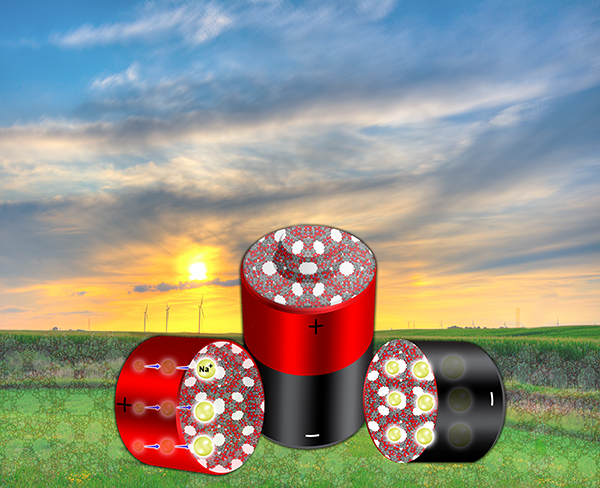
Illustration shows the structural features of a metal-organic framework as featured on the cover of Journal of Materials Chemistry A.
A Sandia interdisciplinary team was the first to report on the feasibility of using metal-organic frameworks as electrodes for Na-ion batteries. Limited energy resources require that innovative storage technologies be identified to provide adequate supply for future demand. The comprehensive study including materials synthesis and battery fabrication revealed a complex interplay between the structural characteristics of the materials and battery components and their cumulative effect on the overall performance. Their work was highlighted on the front cover of Journal of Materials Chemistry A. (2500, 1100)
Carbon dioxide capture technology
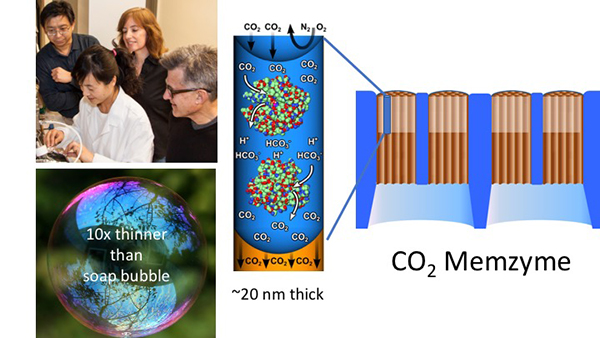
An ultra-thin watery membrane filled with enzymes separates CO2 from gas mixtures cost-effectively. Scientists Ying-Bing Jiang (UNM), Susan Rempe, Jeff Brinker, and Yaqin Fu (UNM) led the Memzyme’s development (clockwise from top left).
Scientists from Sandia and the University of New Mexico collaborated to develop a revolutionary advance in carbon dioxide (CO2) capture technology. By confining water loaded with CO2 enzymes in nanopores in ultra-thin membranes, the team created the Memzyme, which enables CO2 capture from power plants, significantly reducing the threat from greenhouse gases. Applied to a single coal power plant, the annual CO2 emissions avoided by the Memzyme would be equivalent to planting 63 million trees and letting them grow for 10 years. (8600, 1000)
Sandia and the Electric Power Research Institute held the first annual Secure Resilient Microgrid Systems Symposium in Baltimore in 2016. The event attracted about 100 participants from labs, industry, utilities, and government agencies. The symposium covered design and operational tools, methods, standards development, and research needs for secure and resilient microgrids in both civilian and military environments. Forum topics included grid integration and control issues when operating in grid-connected and islanded modes. Participants praised the symposium and expressed a strong desire for continuing the forum. (6100)
Sandia’s Wind Farm Technology Facility (SWiFT) in Lubbock, Texas, recently restarted one of its advanced wind turbines as the final step in a rigorous DOE readiness review that returned SWiFT to full operational capability. Based on the approval, SWiFT performed the first-ever measurements of the wind behind the turbine (i.e., the wake) while also steering the wake to bypass a downwind turbine. Additionally, the SWiFT turbine controller and hardware in the loop system were leveraged by Vestas, the world’s largest wind turbine manufacturer, for its quad-rotor technology demonstrator. (6100, 4100)
HyStEP
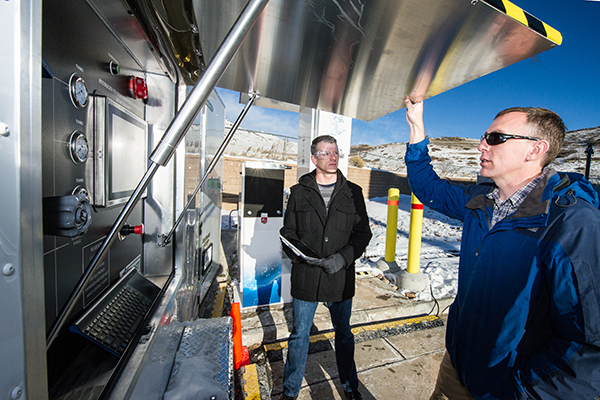
Sandia lead engineer Terry Johnson, left, and NREL engineer Chris Ainscough prepare the Hydrogen Station Equipment Performance (HyStEP) device for testing. (Photo by Dennis Schroeder/NREL)
The Hydrogen Station Equipment Performance (HyStEP) project won a regional Outstanding Partnership Award from the Federal Laboratory Consortium. Developed by Sandia and the National Renewable Energy Laboratory (NREL), the HyStEP device reduces the time to commission new hydrogen fueling stations from as much as months to just one week. HyStEP has been first deployed in California as the state is leading the nation with the most fuel cell electric vehicles on the road and plans to open 35 new retail hydrogen stations by the end of 2016. (8300, 8500)